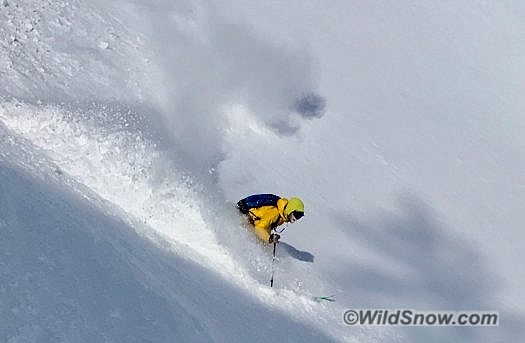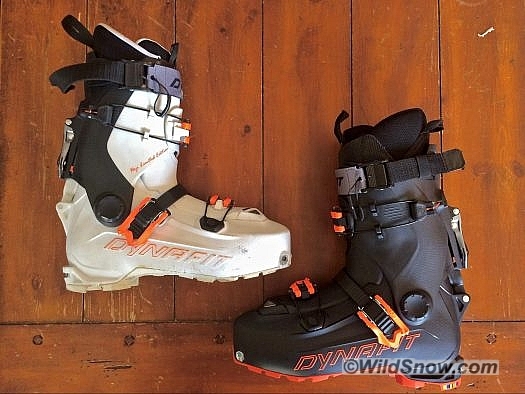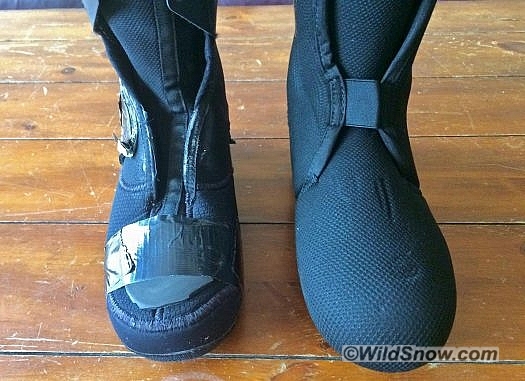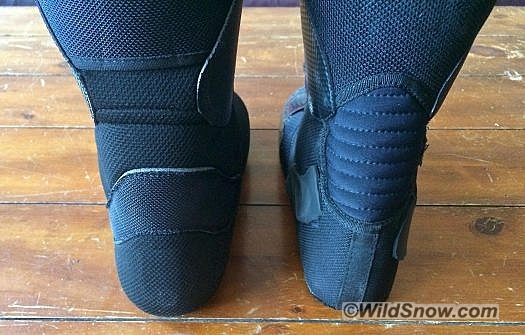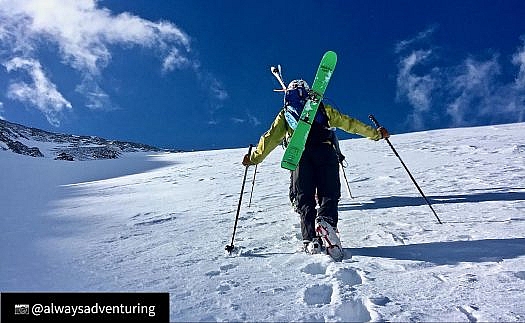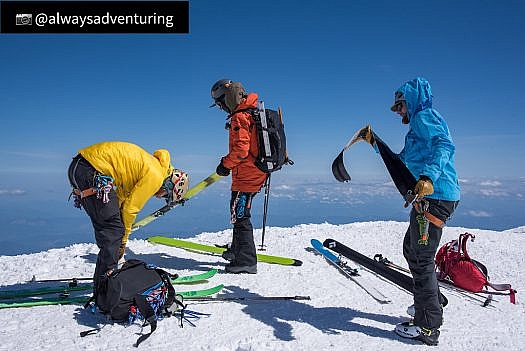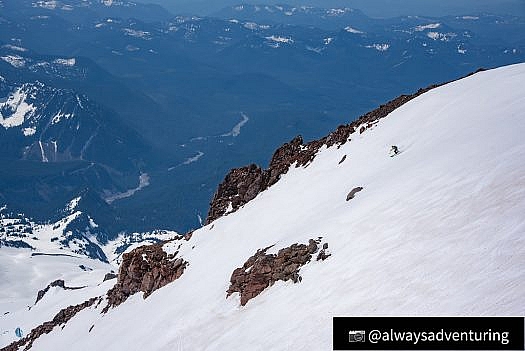Last March was the perfect time to acquire a pair of limited edition tester Hoji Pro Tour boots, and begin dialing them for spring. Colorado was finally getting frozen precipitation, while avalanche danger was reducing at about the same rate as my workload.
I had been following Hoji’s ski touring boot tinkering for years, and had gotten first hand info on his and Fritz Barthel’s “Little Machine” project over a hut brew, in the fabled dining hall of Argentina’s Refugio Frey a couple of summers ago. In Hjorleifson’s observations, the limitations to skiing performance in touring boots come from the lock system between cuff and shell. The various systems all rely on a static catch that allows for play as well as uneven distribution of power from the cuff to the shell. Enter the Hoji Lock. I’ll defer here to Lou’s excellent description of the Hoji Lock system as Lou was privy to the development of this boot since near its conceptual genesis.
Hoji. True skiing performance in a touring boot, coming from an incredible skier with a knack for gear adaptation, and aided by ski touring’s most revolutionary gear developer? The backstory is as great as the boot.
First a little about fit, and unexpected changes in the 18/19 offering. As a boot fitter I’ve observed that 70-80% of you think your feet are “weird” or “strange.” You vehemently inform me of this when trying on ski boots. The truly anomalous feet however would be in the less than 5% range. In other words, most of you are perfectly unique creatures stomping around on somewhat normal feet. I am lucky to classify myself in this very normal end of the uniqueness spectrum: small ankle; medium to wide forefoot; average instep height and have never had any major fitting issues. Most ski boots just fit me.
That said, without modification the limited release Hoji Pro Tour was far from a great fit for me. The toe box was enormous, instep height awkwardly low, and ankle space loose in heel hold while crushing the medial malleolus. I tried the stock liner, an Intuition Pro Tour and a Scarpa F1 Intuition liner, all with limited success. Furthermore, I ended up with a crack in the forefoot of the shell due to maxing out the front buckle over the cavernous forefoot volume (due to the thin liner). An ankle punch took care of the inner ankle. While a heated opening and grinding of both the shell and the underside of the tongue provided space over the navicular area. I then taped and glued copious amounts of foam to the stock liner around the ankle and forefoot, and placed a 2 millimeter shim under the front 3/4 of the liner to snug it up. (This much modification is not an ideal start to any ski touring boot fit. Had I not had the impetus to test the boot, something with a better out-of-box fit would have been the choice.)
Dynafit is known within the industry for their commitment to prompt inline product improvements when shortcomings become apparent. Upon unboxing my newly delivered 18/19 Hoji Pro Tour, I’m happy to report the liner has been completely redesigned and is largely an improvement. The former, limited edition liner was a hastily adapted thinner Vulcan liner that did not mate well with the more spacious shell design. The new liner has a much thicker and seamless forefoot and toe box, a pronounced horse-shoe ankle lock, and is more reactive to heat molding.
The 18/19 Hoji boot feels more snug and comfortable out of the box, mostly a testament to the purpose-built liner. My front buckle went from not able to tighten enough, to latching snugly on the first ladder hook. The fit I would call mostly average, with a (still) slightly lower than most instep, tight ankle, and medium to wide last which feels more snug than the listed 103 millimeters. I am a euro size 43 street shoe and am slightly downsized into the 26.5, which I ski in all brands. A quick eight minute heat mold further dialed in the fit where a mold of the limited edition liner was unnoticeable.
The one regression I see is the practical elimination of a liner flex zone in the rear of the ankle area. This was a result of improving the heel hold, but may have come at too much cost in walk feel. The eight baffles of a softer material have been replaced by a single baffle of the same closed cell foam that makes up the bulk of the liner. Usually this area of a liner will break in after a few tours, but as of now stomping around my living room in one of each boot, the new liner is noticeably more inhibited in rearward flex. (It is possible the lack of flex zone could be remedied with a few judicious gill cuts, stay tuned.)
As for the shell and tongue, there are fewer changes. The tongue has a deeper slit, covered with a softer neoprene-like fabric which appears to be an attempt to counteract the less flexible liner. Note that the Hoji Lock provides all of the forward flex stop, so the shell tongue is just a cover — in many cases it could probably be lighter and thinner. The lower shell opening appears to be more along the lines of what I created with a heat gun and a grinder, giving more room above the arch. Dynafit also added a slight protrusion in the plastic above the power strap to keep it from riding up while walking.
So when the skis hit the snow, how successful were Fritz and Hoji with their goals? I was able to put roughly thirty solid days on the limited release Hoji Pro Tour model last spring in the Colorado alpine with a few 14er skis and some freeride sending missions in the local range. Feeling confident in the boot I then took it on a Pacific Northwest volcano skiing trip last May.
(For reference, I’m 6′ 150 lbs and was skiing the Dynafit Beast 108 ski in a 181 length for the powder sessions, and the 179 cm Black Crows Navis for the mountaineering objectives.)
Walk mode is as good as it gets for a boot that skis this well. The Hoji has a practically uninhibited forward walking range and a rearward resistance only felt on flat skin tracks and road exits (though as mentioned above, a flex zone in the liner would improve this). The Hoji walks and skins slightly better, albeit heavier, than the randonee oriented Scarpa F1 I have skied a lot in, mainly as a result of the forward range. The Pro Tour model weighs in at 1396 g in my 18/19 26.5 with a Superfeet footbed. A minimalist buckle design and thin Grilamid plastics offset the weight of the Hoji Lock system quite nicely.
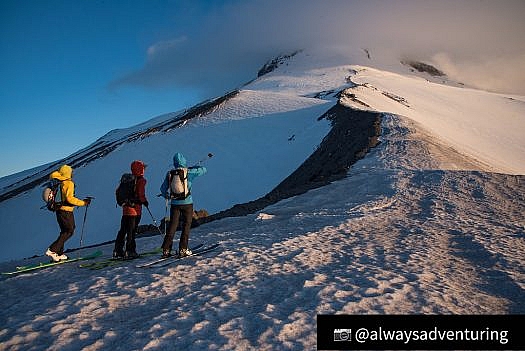
A good boot disappears on your feet, but pops in the morning light (left)? I did like the all white limited edition coloring. Mt. Hood, Oregon.
The one drawback in the Hoji Boot’s design is the unfortunate inclusion of the Speed Nose. I have no doubt that the elimination of a toe lug, thereby bringing the tech fittings tech fittings slightly rearward in comparison to most boots, creates a mathematically more efficient skinning stride. However, the inability to use an automatic crampon is not worth the imperceptible stride gains of the Speed Nose. And the few grams lost are certainly no excuse. (As Lou often does, if you don’t need the full duckbill on your boots you can grind a few millimeters off the front edge, the enormous weight reduction from doing so is always appreciated).
I ended up installing the TLT 7 crampon adapter to my Camp XLC Nanotech crampons last spring and was then equipped to tackle some steeper booters in the Hoji. My $220 high end automatic crampons were now transformed in to a semi-auto offering that I was never able to get fully dialed . This culminated in a dangling set of spikes about two thirds of the way up the Fürher Finger portion of a Mt. Rainier ski. Re-fastening a now semi-auto crampon is about the last thing I wanted to do while dodging the rockfall from the igneous formation slowly crumbling above us in the morning sun.
Dynafit is releasing their answer to this issue with the Cramp-In crampon this year. A small hook has to be installed on the underside of the toe by cutting out a marked section of sole, drilling two holes, and bolting the piece on. You will then hook the front of the Cramp-In there and secure with a traditional heel lever. This simple aluminum design will possibly be the lightest crampon on the market. I do have my concerns about this being a viable option for technical icy terrain, but should be plenty adequate for simple steep snow travel. Packed or iced snow around the hook would seem to be an inevitable nuisance as well. The snub Speed Nose also results non-compatibility with bindings employing an alpine style toe piece. This is not a great concern of mine, but will rule the Hoji out for some, particularly you Salomon/Atomic Shift adopters.
Transitions in the Hoji are a breeze, and yes folks, it is technically possible to ski with your “pants down, always.” The single rear lever locks the upper buckle and power strap where you previously set them for downhill tightness. The idea is you have one lever to throw, like many randonee race boots, and you’re on the go. To achieve this you must position your pant gaiter at the top of the boot above the lock mechanism as to not interfere with its function. The main takeaway here is that transitions are simplified, but pulling your pants up for 30 seconds never really hurt anyone not on the Pierra Menta course. When it’s time to push your pants down and ski, the positive engagement of the Hoji Lock is reassuring. The pretensioned system locks you into perfect forward lean with zero play fore or aft. Now THAT feels like a ski boot.
How about skiing performance? Raise your hand if you want to ski beautiful backcountry lines fast and/or aggressively on bigger touring skis! The flex achieved by the Hoji Lock system is phenomenal. Whether you are going for the big missions in style or want nothing more than a solid ski touring boot with the most even flex available, the Hoji is a wonderful innovation. I haven’t skied an alpine boot in over six years, and had forgotten the feeling of zero play and smooth flex when those alone are the design objectives. Fritz and Eric achieved this feel in a capable uphill boot. Most touring boots in the beefier end of the spectrum tend to flex reasonably well until you hit a wall in the motion. The Hoji flexes evenly throughout range, allowing touch and finesse in the deepest part of the turn. This is especially noticeable during high speed turns or in steep terrain, when you need to fully flex the uphill boot in order to pressure the important downhill ski while staying centered.
Our days on Mt. Rainier this past May were my best Hoji testing of the entire spring. After pushing through the aforementioned morning meteor shower, we gained the summit, then cruised down the Nisqually glacier back to the Fürher Finger to find it in perfect corn condition. It’s not often that you and your buddies get to treat the steep section of a classic descent like a giant slalom course. The Hoji boot drove my Navis’ with both power and finesse on one of my favorite ski descents ever. We spent several days on Rainier and I was glad to have the extra boot beef while skiing with an overnight pack in the hot and heavy spring snow.
The Hoji is certainly stiff enough for most applications, but not the stiffest ski touring boot out there. A couple of times I was able to push through the flex and bottom them out. These scenarios were front seat landings and encountering an unexpected bump or change in snow quality at higher speeds, or heavy spring snow while carrying an overnight backcountry pack. I would attribute these instances to reckless skiing. Better or more conservative skiers at anywhere near my height and weight should find the boot plenty adequate.
Hoji has said this is not a purpose built freeride boot, and there may be a freeride model in the future. I would offer, however, that to Eric “freeride” is strictly what he and his counterparts are doing on-camera with speeds in excess of 50 mph, giant multi-stack pillow lines, and stomping enormous hucks. To me and most WildSnow readers, backcountry freeriding means skiing with an elevated style and aggression beyond simply descending a slope. That is, something like speeds creeping over 30 mph and Napoleon Dynamite perceptions of air, which are well within the realm of the Hoji Boot’s capabilities.
The Hoji Pro Tour is the best touring boot I have ever skied. I will continue to use the lighter Scarpa Alien RS for big days, faster travel, with smaller skis, and on more technical routes. But my feet will spend significant time in the Hoji this season, as it is an excellent tourer that you can ski without babying or adjustment in style. When it is time to pull out the bigger boards and ski with purpose, the Hoji will be my slipper of choice.
(Wildsnow guest blogger Gary Smith is an avid backcountry skier and ski mountaineer residing in Eagle County, Colorado. You can find him at Cripple Creek Backcountry in Vail when he is not in search of steep lines or face shots. Visit @ghostrider.gary on Instagram for ski shots and snippets of mountain life.)
On March 22nd 2021, Gary Smith tragically died in an avalanche outside of Beaver Creek Resort in Colorado. Since 2018, Gary has been a frequent and insightful contributor to WildSnow. From Christmas Eve spent at the Wildsnow Field HQ cabin, to testing gear and sharing his love for steep skiing around the world, he was a pillar of the ski touring community and will be greatly missed.

